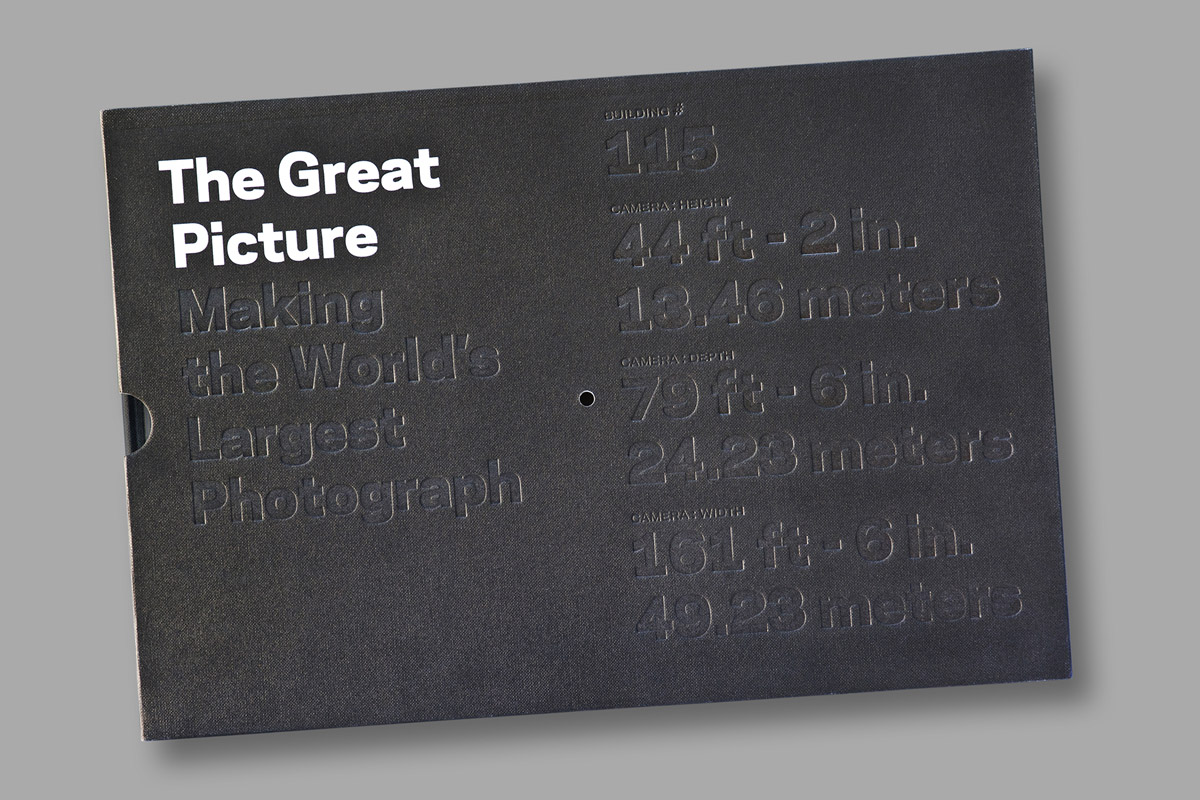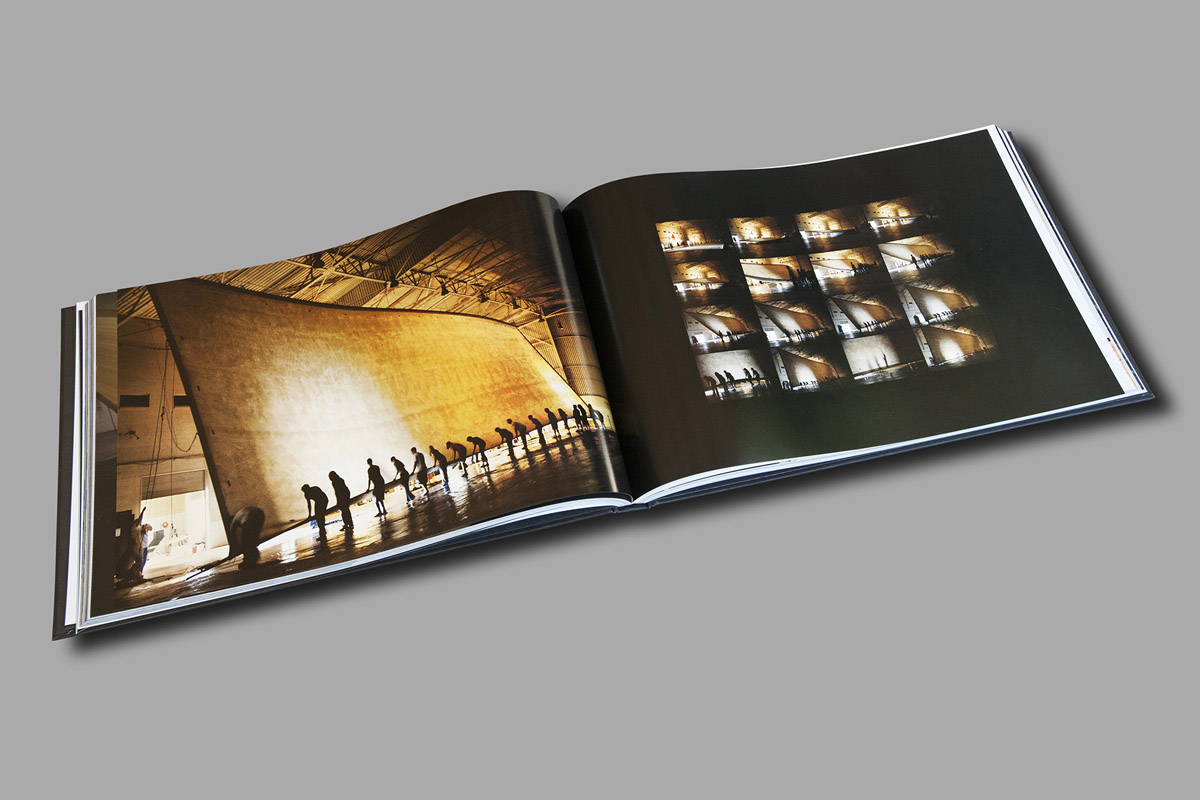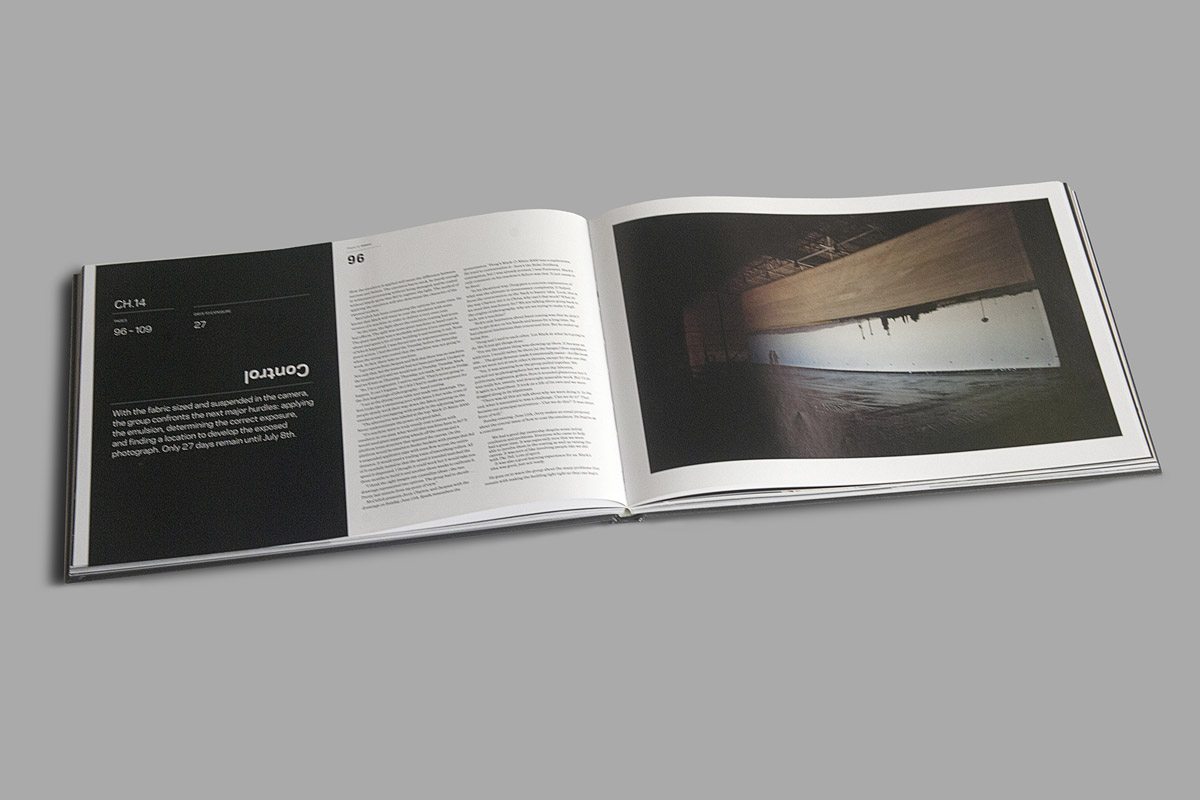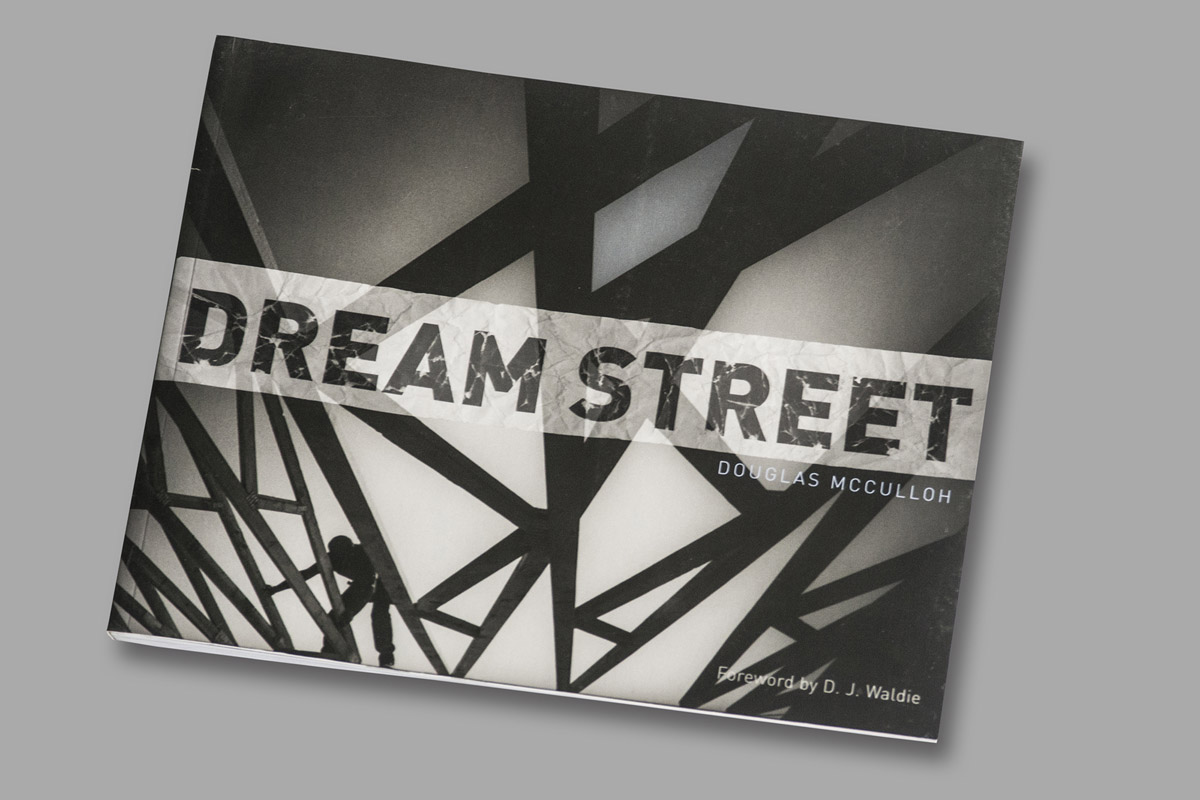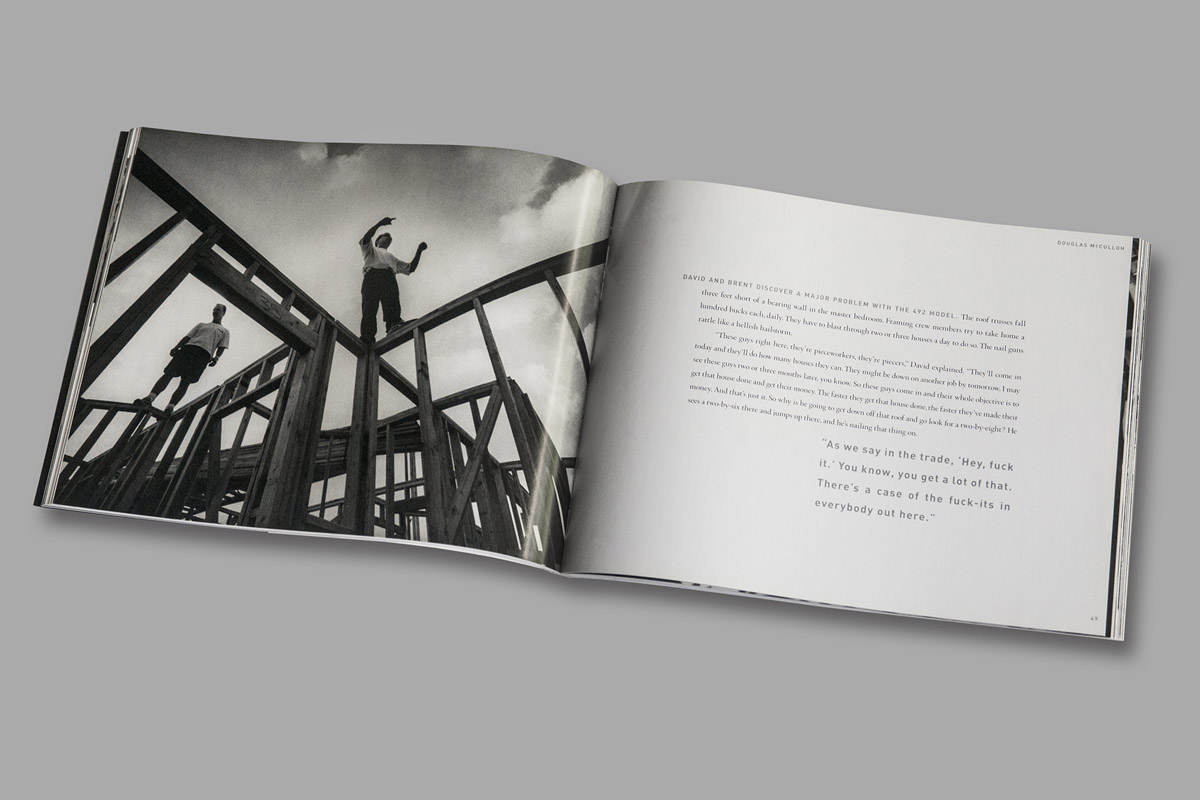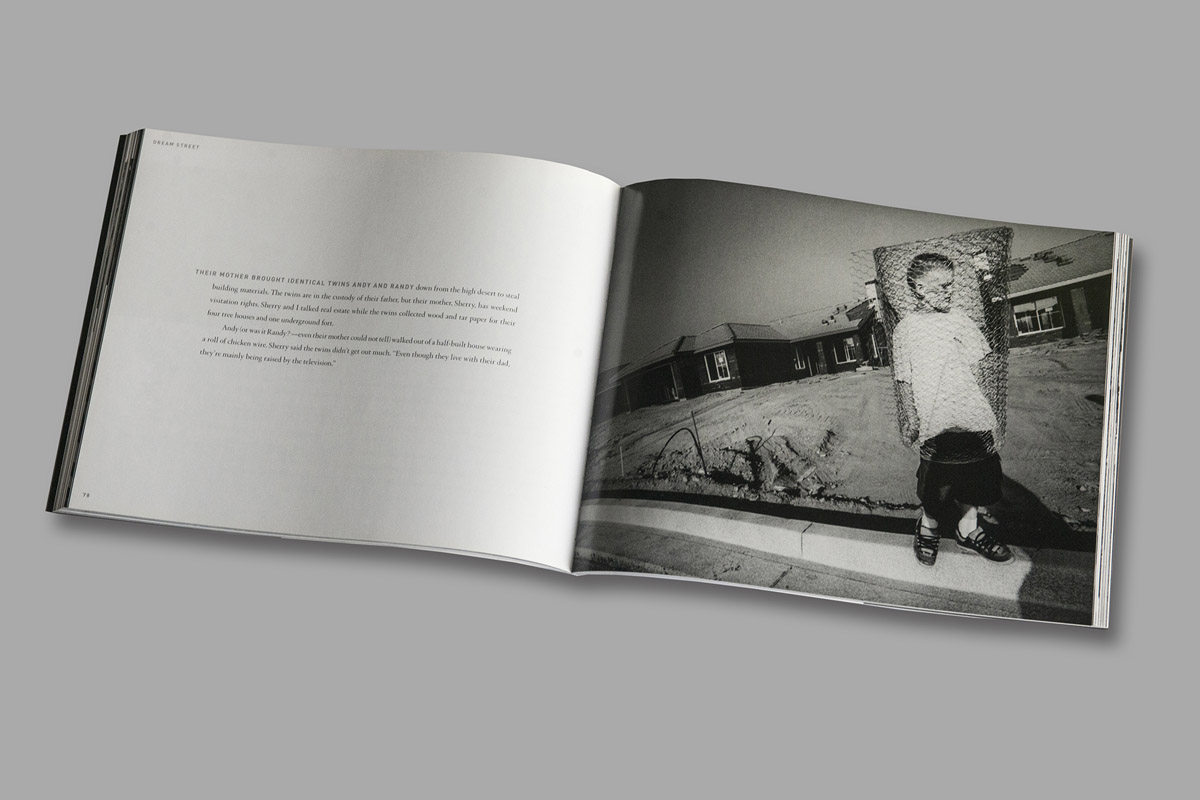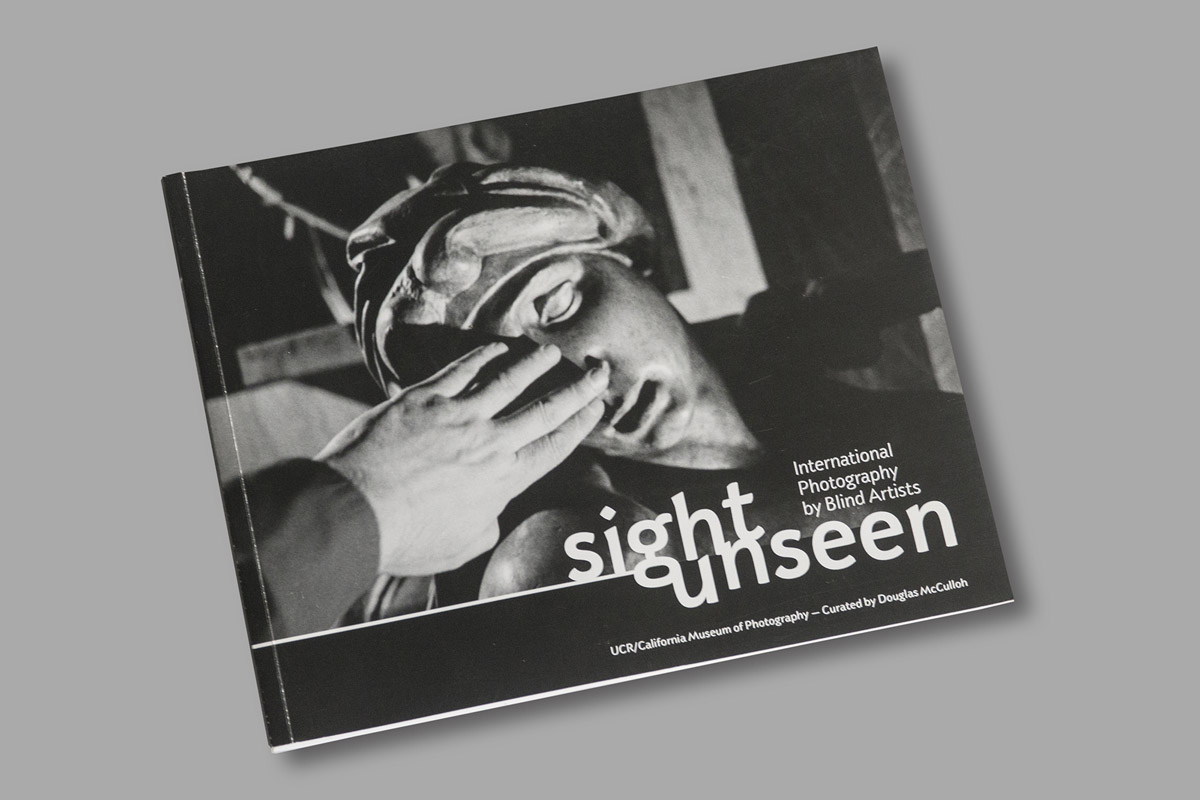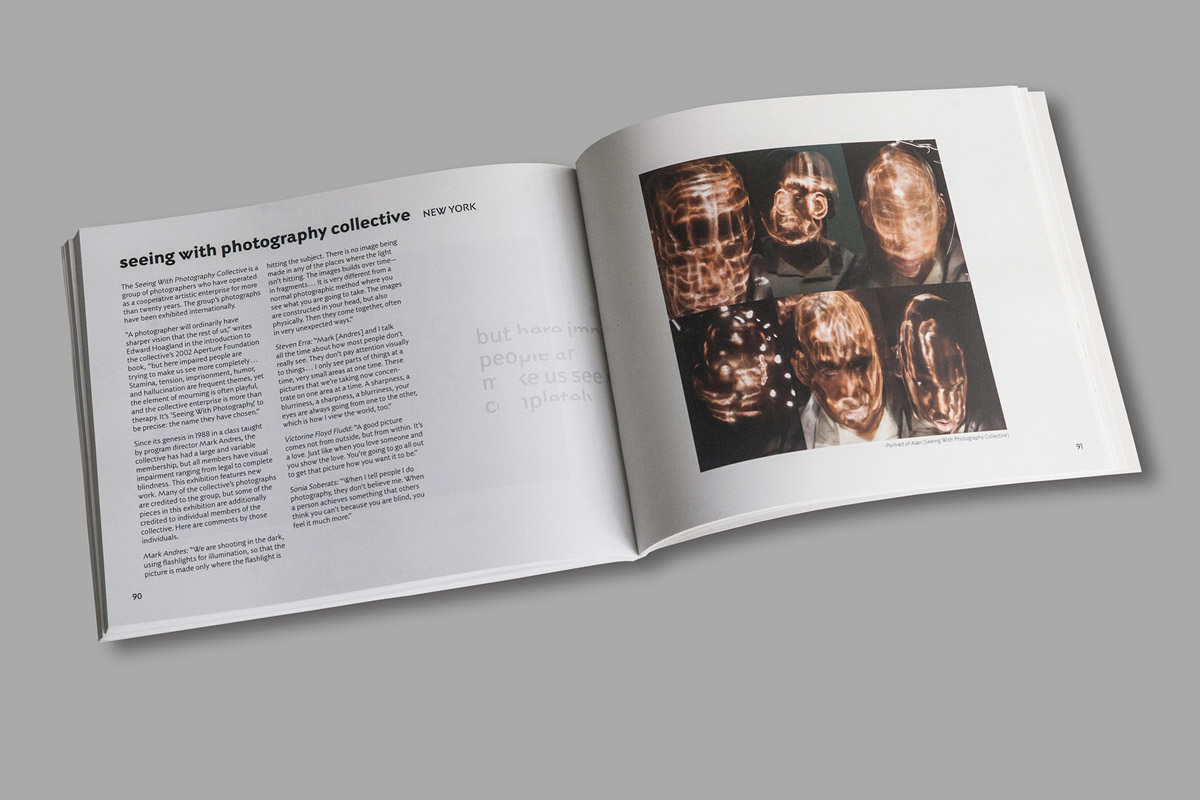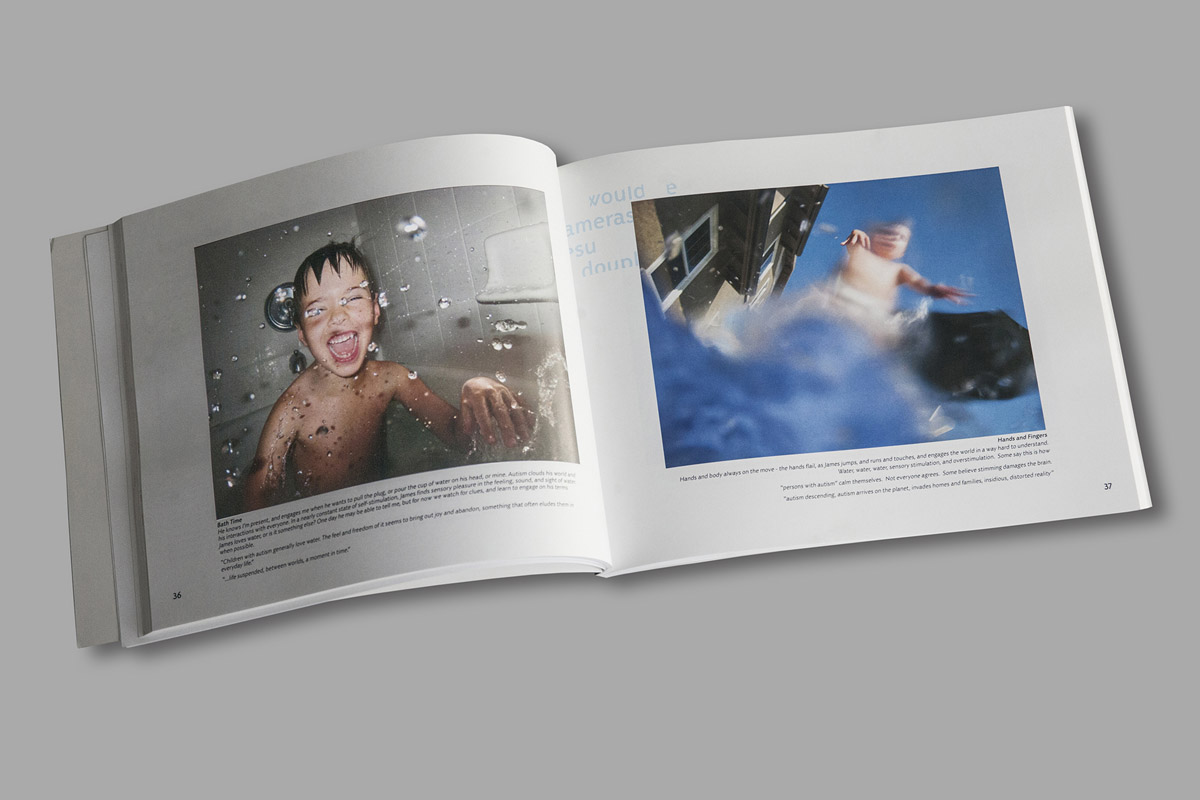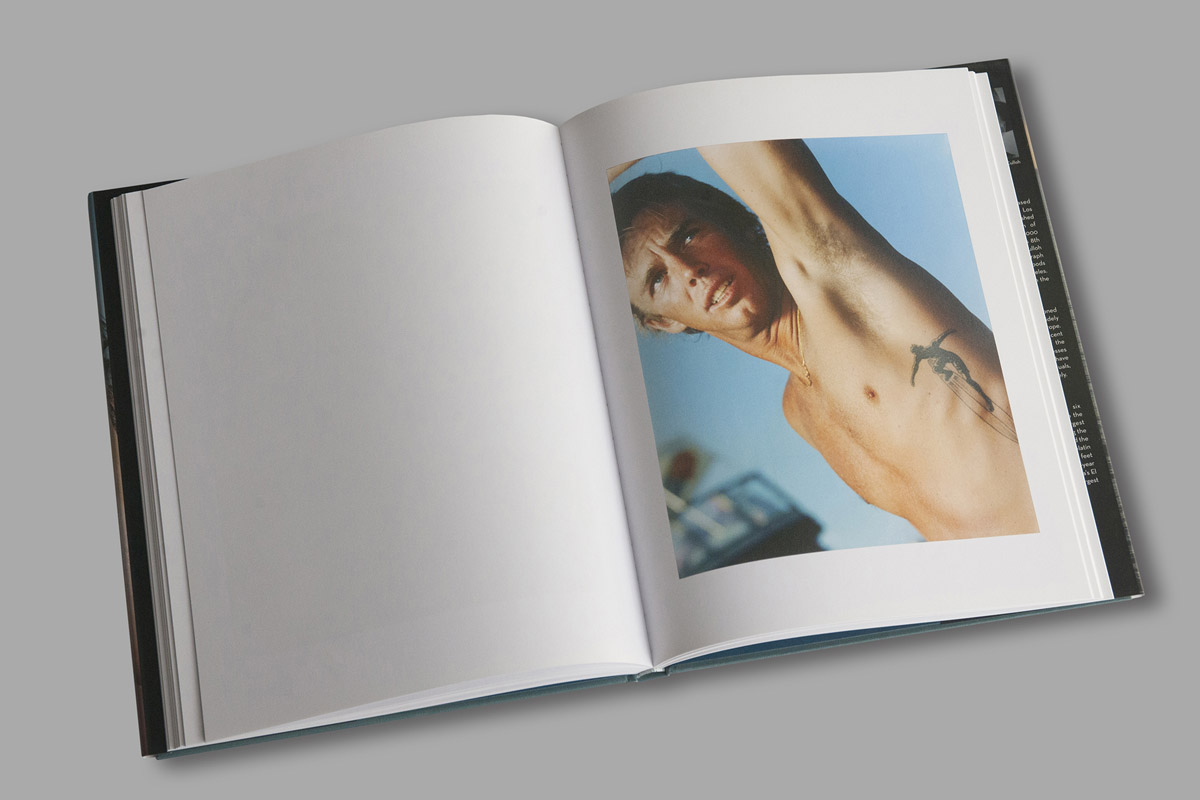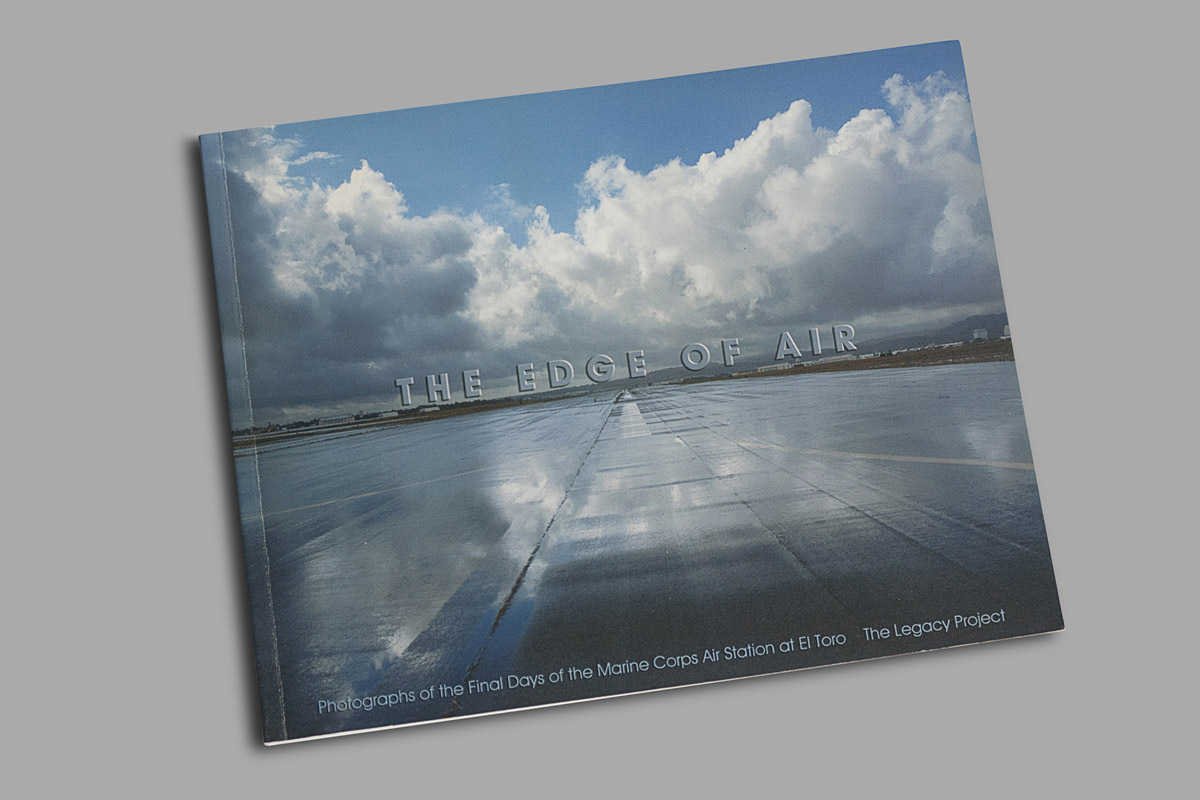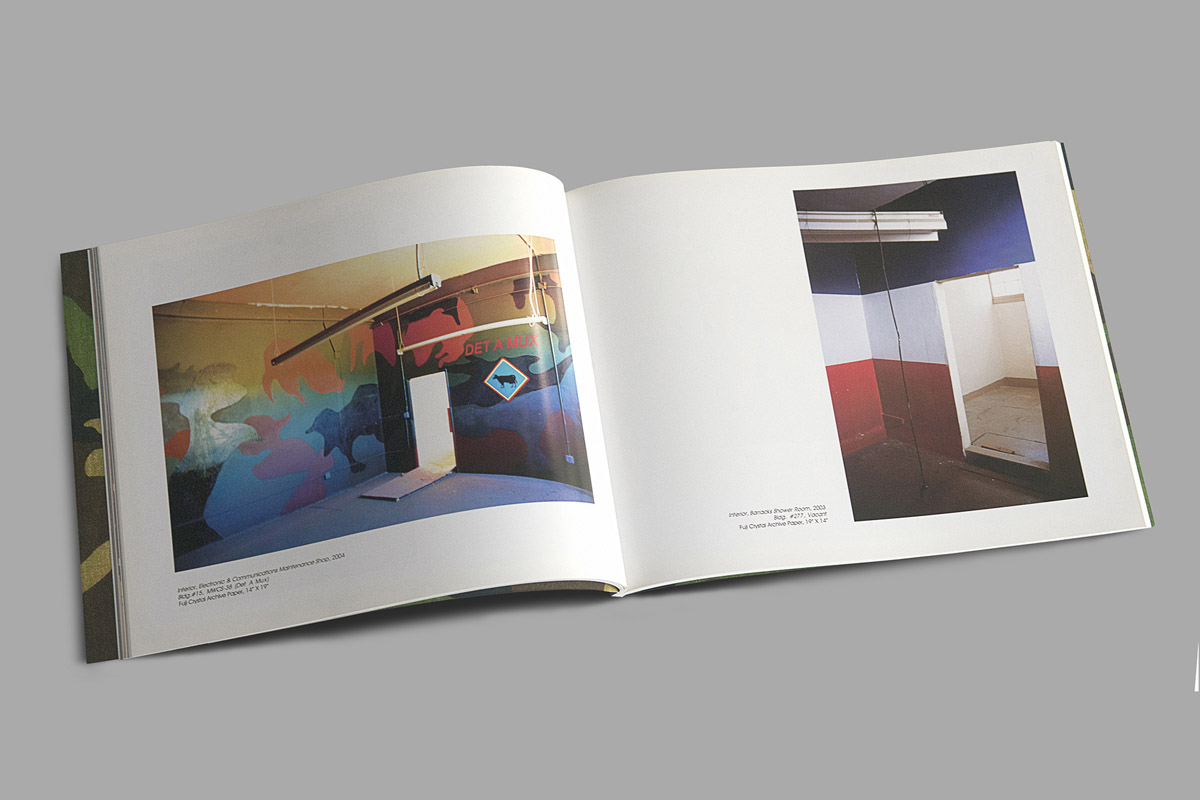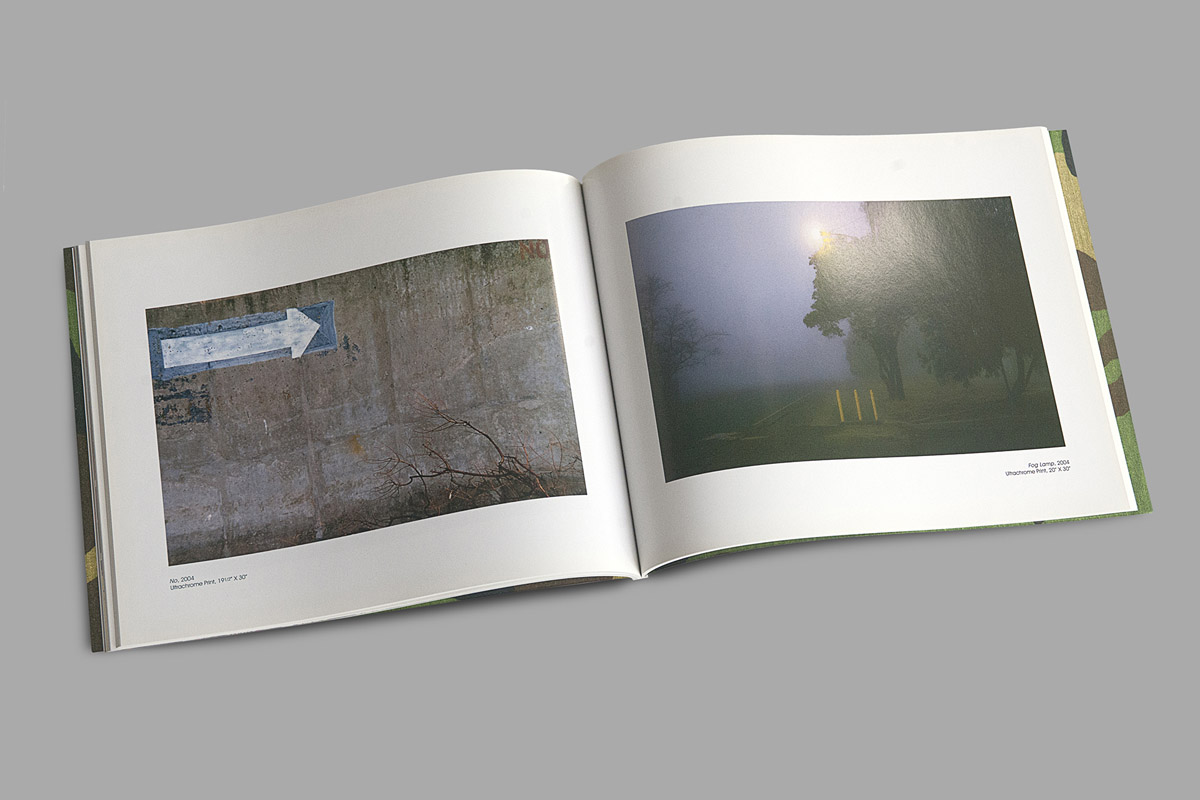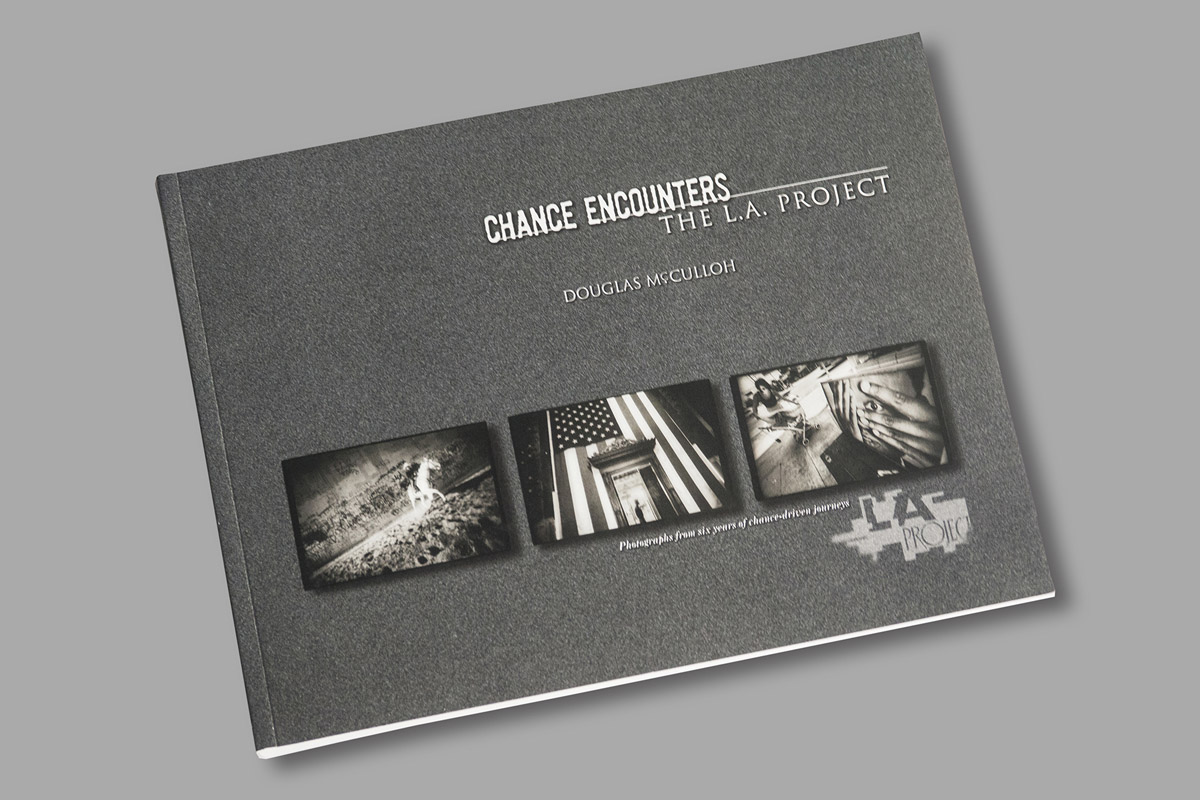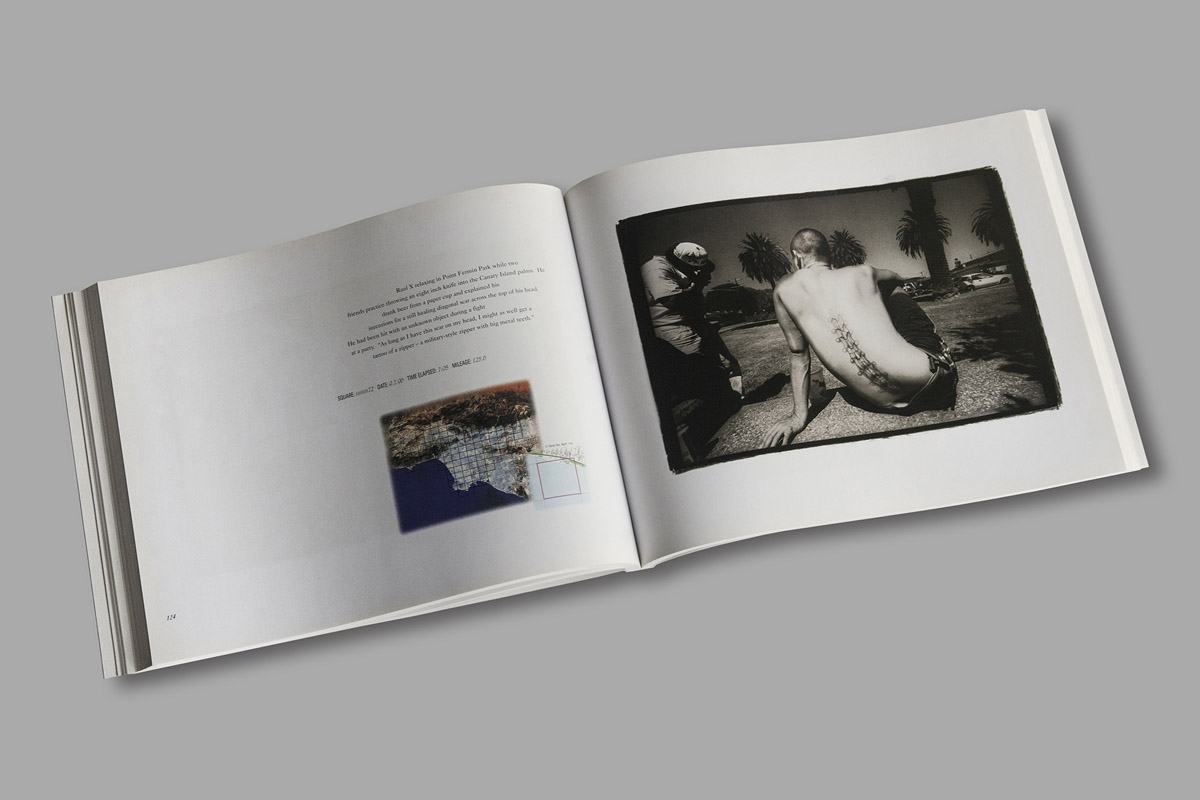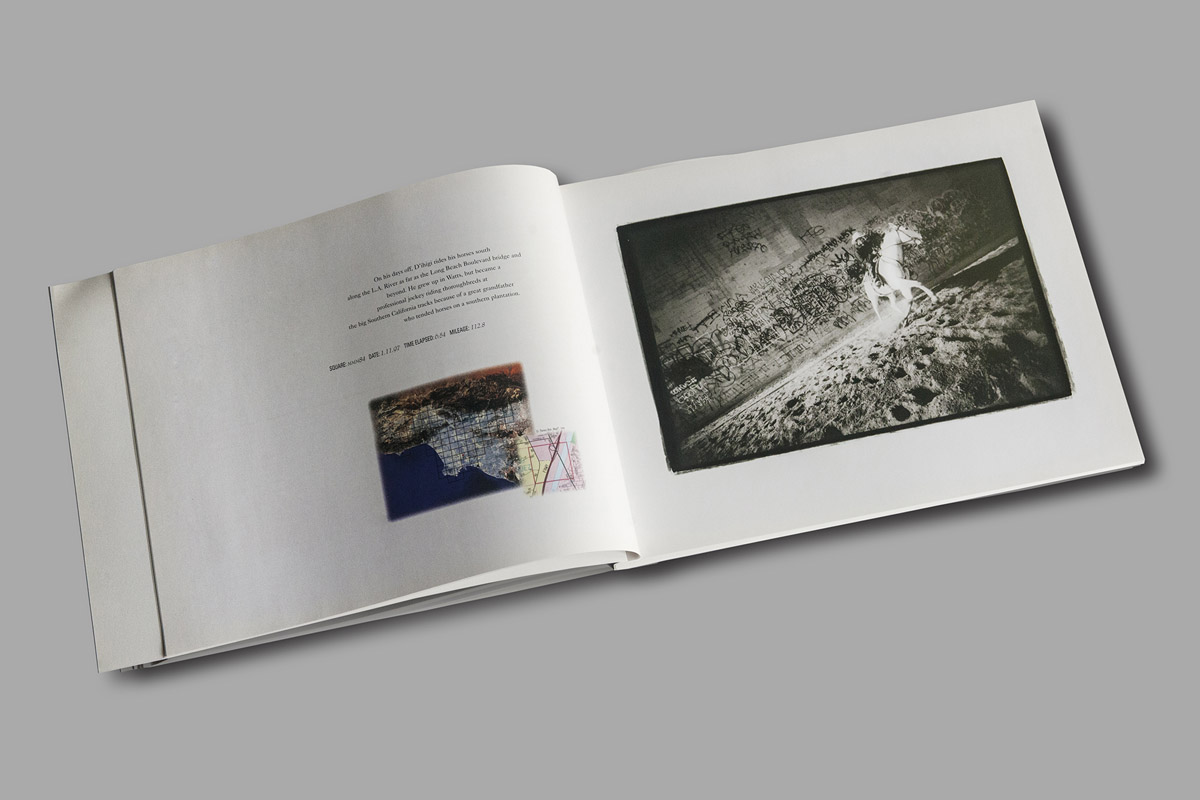Books
Photo Description
The Great Picture: Making the World’s Largest Photograph
Publisher: Hudson Hills Press, New York.
2012; 196 pages; hardcover with slipcase; hand-tipped double gatefold; large-scale folio size 14.5 x 9.5 inches
Essays by Lucy R. Lippard and Tyler Stallings; narrative by Dawn Hassett; richly illustrated.
Winner of the “Typographic Excellence Design Award” from the Type Directors Club, the leading international organization recognizing excellence in the use of type and the letterform in graphic design.
ISBN 978-1555953737
The epic story of the largest photograph ever made—produced to mark the border crossing from 165 years of film/chemistry-based photography into the digital age. The Great Picture is a huge single-piece gelatin silver image made by transforming a closed military jet hangar in southern California into a gigantic camera. The 3,505.75 square-foot (325.44 m²) photograph was made by The Legacy Group: Jerry Burchfield, Mark Chamberlain, Jacques Garnier, Rob Johnson, Douglas McCulloh, and Clayton Spada. The photograph is 31 feet, 7 inches (9.62 meters) high by 111 feet (33.83 meters) wide. The Great Picture has been written about in more than 500 publications including Art in America, Photographie, AfterImage, Juxtapoz, Black and White Magazine, New York Times, Washington Post, Los Angeles Times, San Francisco Chronicle, Toronto Star, Chicago Tribune, Der Spiegel (Germany), and The Guardian (England).
“It’s a negative from the very beginning of photography and a digital positive. It’s the bracket. On one side, the infancy of photography and on the other, the technological revolution.” —Carol McCusker, Museum of Photographic Arts, San Diego
The Great Picture: Making the World’s Largest Photograph
Publisher: Hudson Hills Press, New York.
2012; 196 pages; hardcover with slipcase; hand-tipped double gatefold; large-scale folio size 14.5 x 9.5 inches
Essays by Lucy R. Lippard and Tyler Stallings; narrative by Dawn Hassett; richly illustrated.
Winner of the “Typographic Excellence Design Award” from the Type Directors Club, the leading international organization recognizing excellence in the use of type and the letterform in graphic design.
ISBN 978-1555953737
The epic story of the largest photograph ever made—produced to mark the border crossing from 165 years of film/chemistry-based photography into the digital age. The Great Picture is a huge single-piece gelatin silver image made by transforming a closed military jet hangar in southern California into a gigantic camera. The 3,505.75 square-foot (325.44 m²) photograph was made by The Legacy Group: Jerry Burchfield, Mark Chamberlain, Jacques Garnier, Rob Johnson, Douglas McCulloh, and Clayton Spada. The photograph is 31 feet, 7 inches (9.62 meters) high by 111 feet (33.83 meters) wide. The Great Picture has been written about in more than 500 publications including Art in America, Photographie, AfterImage, Juxtapoz, Black and White Magazine, New York Times, Washington Post, Los Angeles Times, San Francisco Chronicle, Toronto Star, Chicago Tribune, Der Spiegel (Germany), and The Guardian (England).
“It’s a negative from the very beginning of photography and a digital positive. It’s the bracket. On one side, the infancy of photography and on the other, the technological revolution.” —Carol McCusker, Museum of Photographic Arts, San Diego
The Great Picture: Making the World’s Largest Photograph
Publisher: Hudson Hills Press, New York.
2012; 196 pages; hardcover with slipcase; hand-tipped double gatefold; large-scale folio size 14.5 x 9.5 inches
Essays by Lucy R. Lippard and Tyler Stallings; narrative by Dawn Hassett; richly illustrated.
Winner of the “Typographic Excellence Design Award” from the Type Directors Club, the leading international organization recognizing excellence in the use of type and the letterform in graphic design.
ISBN 978-1555953737
The epic story of the largest photograph ever made—produced to mark the border crossing from 165 years of film/chemistry-based photography into the digital age. The Great Picture is a huge single-piece gelatin silver image made by transforming a closed military jet hangar in southern California into a gigantic camera. The 3,505.75 square-foot (325.44 m²) photograph was made by The Legacy Group: Jerry Burchfield, Mark Chamberlain, Jacques Garnier, Rob Johnson, Douglas McCulloh, and Clayton Spada. The photograph is 31 feet, 7 inches (9.62 meters) high by 111 feet (33.83 meters) wide. The Great Picture has been written about in more than 500 publications including Art in America, Photographie, AfterImage, Juxtapoz, Black and White Magazine, New York Times, Washington Post, Los Angeles Times, San Francisco Chronicle, Toronto Star, Chicago Tribune, Der Spiegel (Germany), and The Guardian (England).
“It’s a negative from the very beginning of photography and a digital positive. It’s the bracket. On one side, the infancy of photography and on the other, the technological revolution.” —Carol McCusker, Museum of Photographic Arts, San Diego
Dream Street
Publisher: Heyday Books, Berkeley, California
2009; 176 pages; 11 x 8.5 inches
ISBN 978-1597141031
“I won the right to name a street in southern California,” writes photographer and author Douglas McCulloh. The chance win at a charity event launched McCulloh into an obsessive relationship with a 134-home subdivision just commencing in southern California. Increasingly captivated with the creation of the new neighborhood, he haunted the place he named Dream Street, vividly chronicling the lives of builders, workers, and prospective homebuyers with his camera and tape recorder.
By a fateful quirk of timing, McCulloh’s presence at Dream Street also cuts a clean slice straight through the heart of the U.S. housing boom and bust. Dream Street, in short, becomes a universal story, a microcosm of the new America, a place populated by memorable characters reaching for their dreams and dealing with realities. McCulloh’s timely and captivating work illuminates the history and fate of Dream Streets everywhere.
“Documenting the birth of a suburb I can think of no other recent account of the suburbs that has the heartbreaking qualities of McCulloh’s Dream Street. Only in the novels of the opening of the Great Plains at the turn of the century are the social, economic, and environmental forces that shaped the making of a place so clearly drawn, and on so human a scale.” —D. J. Waldie, author of Holy Land
“Dream Street is a disturbing yet moving portrait of lives indentured to that ruthless outdoor sweatshop known as the home construction industry. McCulloh confronts us with the exploitation and downward mobility that manufactures the mirage of suburban affluence.” —Mike Davis, author of City of Quartz: Excavating the Future in Los Angeles
Dream Street
Publisher: Heyday Books, Berkeley, California
2009; 176 pages; 11 x 8.5 inches
ISBN 978-1597141031
“I won the right to name a street in southern California,” writes photographer and author Douglas McCulloh. The chance win at a charity event launched McCulloh into an obsessive relationship with a 134-home subdivision just commencing in southern California. Increasingly captivated with the creation of the new neighborhood, he haunted the place he named Dream Street, vividly chronicling the lives of builders, workers, and prospective homebuyers with his camera and tape recorder.
By a fateful quirk of timing, McCulloh’s presence at Dream Street also cuts a clean slice straight through the heart of the U.S. housing boom and bust. Dream Street, in short, becomes a universal story, a microcosm of the new America, a place populated by memorable characters reaching for their dreams and dealing with realities. McCulloh’s timely and captivating work illuminates the history and fate of Dream Streets everywhere.
“Documenting the birth of a suburb I can think of no other recent account of the suburbs that has the heartbreaking qualities of McCulloh’s Dream Street. Only in the novels of the opening of the Great Plains at the turn of the century are the social, economic, and environmental forces that shaped the making of a place so clearly drawn, and on so human a scale.” —D. J. Waldie, author of Holy Land
“Dream Street is a disturbing yet moving portrait of lives indentured to that ruthless outdoor sweatshop known as the home construction industry. McCulloh confronts us with the exploitation and downward mobility that manufactures the mirage of suburban affluence.” —Mike Davis, author of City of Quartz: Excavating the Future in Los Angeles
Dream Street
Publisher: Heyday Books, Berkeley, California
2009; 176 pages; 11 x 8.5 inches
ISBN 978-1597141031
“I won the right to name a street in southern California,” writes photographer and author Douglas McCulloh. The chance win at a charity event launched McCulloh into an obsessive relationship with a 134-home subdivision just commencing in southern California. Increasingly captivated with the creation of the new neighborhood, he haunted the place he named Dream Street, vividly chronicling the lives of builders, workers, and prospective homebuyers with his camera and tape recorder.
By a fateful quirk of timing, McCulloh’s presence at Dream Street also cuts a clean slice straight through the heart of the U.S. housing boom and bust. Dream Street, in short, becomes a universal story, a microcosm of the new America, a place populated by memorable characters reaching for their dreams and dealing with realities. McCulloh’s timely and captivating work illuminates the history and fate of Dream Streets everywhere.
“Documenting the birth of a suburb I can think of no other recent account of the suburbs that has the heartbreaking qualities of McCulloh’s Dream Street. Only in the novels of the opening of the Great Plains at the turn of the century are the social, economic, and environmental forces that shaped the making of a place so clearly drawn, and on so human a scale.” —D. J. Waldie, author of Holy Land
“Dream Street is a disturbing yet moving portrait of lives indentured to that ruthless outdoor sweatshop known as the home construction industry. McCulloh confronts us with the exploitation and downward mobility that manufactures the mirage of suburban affluence.” —Mike Davis, author of City of Quartz: Excavating the Future in Los Angeles
Sight Unseen: International Photography by Blind Artists
Publisher: University of California/California Museum of Photography
2009;118 pages; 10 x 8 inches
ISBN 9780982304617
This groundbreaking book (and traveling exhibition) presents a broad sample of work by twelve of the most accomplished blind photographers in the world. It is the first major survey on a rich subject full of paradox and revelation. Images and essays explore the ground zero of photography, sight, and vision. A blind person pressing the camera shutter is also political. It’s an act that lays claim to the visual world and forces a reevaluation of ideas about blindness. The photographs in this book operate in the gap between physical sight and the deep human need for images, and challenge us to reevaluate what it means to see.
“The common conception is that you make photographs with your eyes, but any photographer will tell you, you actually make photographs with your mind. And so these are very, very pure photographers. They are operating inside their heads to create images. And, eventually, they use a camera like anyone else to bring a photograph into the world for the rest of us to see.” —BBC World Service, ‘The World Today with Owen Bennett Jones’
Sight Unseen: International Photography by Blind Artists
Publisher: University of California/California Museum of Photography
2009;118 pages; 10 x 8 inches
ISBN 9780982304617
This groundbreaking book (and traveling exhibition) presents a broad sample of work by twelve of the most accomplished blind photographers in the world. It is the first major survey on a rich subject full of paradox and revelation. Images and essays explore the ground zero of photography, sight, and vision. A blind person pressing the camera shutter is also political. It’s an act that lays claim to the visual world and forces a reevaluation of ideas about blindness. The photographs in this book operate in the gap between physical sight and the deep human need for images, and challenge us to reevaluate what it means to see.
“The common conception is that you make photographs with your eyes, but any photographer will tell you, you actually make photographs with your mind. And so these are very, very pure photographers. They are operating inside their heads to create images. And, eventually, they use a camera like anyone else to bring a photograph into the world for the rest of us to see.” —BBC World Service, ‘The World Today with Owen Bennett Jones’
Sight Unseen: International Photography by Blind Artists
Publisher: University of California/California Museum of Photography
2009;118 pages; 10 x 8 inches
ISBN 9780982304617
This groundbreaking book (and traveling exhibition) presents a broad sample of work by twelve of the most accomplished blind photographers in the world. It is the first major survey on a rich subject full of paradox and revelation. Images and essays explore the ground zero of photography, sight, and vision. A blind person pressing the camera shutter is also political. It’s an act that lays claim to the visual world and forces a reevaluation of ideas about blindness. The photographs in this book operate in the gap between physical sight and the deep human need for images, and challenge us to reevaluate what it means to see.
“The common conception is that you make photographs with your eyes, but any photographer will tell you, you actually make photographs with your mind. And so these are very, very pure photographers. They are operating inside their heads to create images. And, eventually, they use a camera like anyone else to bring a photograph into the world for the rest of us to see.” —BBC World Service, ‘The World Today with Owen Bennett Jones’
On the Beach: Chance Portraits from Two Shores
Publisher: Southeast Museum of Photography, Florida
2006; 152 pages; 12 x 9.5 inches, hardcover
ISBN 978-0978907204
The memorable and sometimes aggressive photographic portraits of On The Beach are the result of a multi-year project by two well-known photographers, Douglas McCulloh and Jacques Garnier. The photographs of On The Beach are beach images unlike any others: quirky, engaging, and often starkly revealing. On The Beach rises from a powerfully straightforward idea—go to beaches and capture a cross-section of beachgoers. The concept of sampling drives the project. In the words of artist Sol LeWitt, “The idea becomes the machine that makes the art.” These portraits are unrehearsed and unposed. Part happening, part ritual, part spontaneous ballet, the photographs meet at the intersection of chance and magic. The photographers place a studio lighting setup directly in the sand, making California and Florida beaches their backdrop. The beach eliminates conceits, concealment, and clothing. People who cross onto the sand become a little naked. To this equation of vulnerability, the two photographers add unforgiving strobe lights and a ruthless high resolution camera. In truth, they are setting a trap.
“Garnier and McCulloh’s odd beach populace are more akin to those found in Diane Arbus’s New York City or August Sander’s Germany who, each in their own way, approached their native lands as unfamiliar ones... In the case of these artists, their portraits are not only documentaries, but allegories for their times.” —Tyler Stallings, chief curator, Laguna Art Museum, Laguna Beach, California
On the Beach: Chance Portraits from Two Shores
Publisher: Southeast Museum of Photography, Florida
2006; 152 pages; 12 x 9.5 inches, hardcover
ISBN 978-0978907204
The memorable and sometimes aggressive photographic portraits of On The Beach are the result of a multi-year project by two well-known photographers, Douglas McCulloh and Jacques Garnier. The photographs of On The Beach are beach images unlike any others: quirky, engaging, and often starkly revealing. On The Beach rises from a powerfully straightforward idea—go to beaches and capture a cross-section of beachgoers. The concept of sampling drives the project. In the words of artist Sol LeWitt, “The idea becomes the machine that makes the art.” These portraits are unrehearsed and unposed. Part happening, part ritual, part spontaneous ballet, the photographs meet at the intersection of chance and magic. The photographers place a studio lighting setup directly in the sand, making California and Florida beaches their backdrop. The beach eliminates conceits, concealment, and clothing. People who cross onto the sand become a little naked. To this equation of vulnerability, the two photographers add unforgiving strobe lights and a ruthless high resolution camera. In truth, they are setting a trap.
“Garnier and McCulloh’s odd beach populace are more akin to those found in Diane Arbus’s New York City or August Sander’s Germany who, each in their own way, approached their native lands as unfamiliar ones... In the case of these artists, their portraits are not only documentaries, but allegories for their times.” —Tyler Stallings, chief curator, Laguna Art Museum, Laguna Beach, California
On the Beach: Chance Portraits from Two Shores
Publisher: Southeast Museum of Photography, Florida
2006; 152 pages; 12 x 9.5 inches, hardcover
ISBN 978-0978907204
The memorable and sometimes aggressive photographic portraits of On The Beach are the result of a multi-year project by two well-known photographers, Douglas McCulloh and Jacques Garnier. The photographs of On The Beach are beach images unlike any others: quirky, engaging, and often starkly revealing. On The Beach rises from a powerfully straightforward idea—go to beaches and capture a cross-section of beachgoers. The concept of sampling drives the project. In the words of artist Sol LeWitt, “The idea becomes the machine that makes the art.” These portraits are unrehearsed and unposed. Part happening, part ritual, part spontaneous ballet, the photographs meet at the intersection of chance and magic. The photographers place a studio lighting setup directly in the sand, making California and Florida beaches their backdrop. The beach eliminates conceits, concealment, and clothing. People who cross onto the sand become a little naked. To this equation of vulnerability, the two photographers add unforgiving strobe lights and a ruthless high resolution camera. In truth, they are setting a trap.
“Garnier and McCulloh’s odd beach populace are more akin to those found in Diane Arbus’s New York City or August Sander’s Germany who, each in their own way, approached their native lands as unfamiliar ones... In the case of these artists, their portraits are not only documentaries, but allegories for their times.” —Tyler Stallings, chief curator, Laguna Art Museum, Laguna Beach, California
The Edge of Air
Publisher: Laguna Wilderness Press, Laguna Beach, California.
2005; 96 pages; hardcover, softcover, and slipcased special edition; 10.75 x 8.5 inches; essays by Mark Johnstone and James Scarborough; richly illustrated.
ISBN: 978-0972854450
“A group obsession.” That’s how noted critic and writer Lucy R. Lippard summarizes the Legacy Project—“marvelously extravagant,” “obsessively detailed,” producers of a “photographic sea.”
“For all its unprecedented size,” states Lippard, “[the world’s largest photograph] pales beside the ongoing documentation of Marine Corps Air Station El Toro undertaken by the photographic team—well over 150,000 photographs, and counting. The artists set out to make as realistic a document as possible of the fifteen-year evolution of El Toro, leaving few stones unturned. They systematically shot each of the more than 1,800 structures on the base: they made quarterly aerial shoots and did ‘walkabouts’ over the same five-mile course with four cameras, pointing in each of the cardinal directions, shooting every thirty paces.”
“The Legacy Group photographers are unlocking (or providing a window on) the past and positioning it for the future. They have unfettered access to almost every nook and cranny of the air base and have entered into dialogues, both familiar and unpredictable, with all of it. Their images have overlays of irony, fetish, mysticism, and poetry.” —Mark Johnstone, writer and curator
The Edge of Air
Publisher: Laguna Wilderness Press, Laguna Beach, California.
2005; 96 pages; hardcover, softcover, and slipcased special edition; 10.75 x 8.5 inches; essays by Mark Johnstone and James Scarborough; richly illustrated.
ISBN: 978-0972854450
“A group obsession.” That’s how noted critic and writer Lucy R. Lippard summarizes the Legacy Project—“marvelously extravagant,” “obsessively detailed,” producers of a “photographic sea.”
“For all its unprecedented size,” states Lippard, “[the world’s largest photograph] pales beside the ongoing documentation of Marine Corps Air Station El Toro undertaken by the photographic team—well over 150,000 photographs, and counting. The artists set out to make as realistic a document as possible of the fifteen-year evolution of El Toro, leaving few stones unturned. They systematically shot each of the more than 1,800 structures on the base: they made quarterly aerial shoots and did ‘walkabouts’ over the same five-mile course with four cameras, pointing in each of the cardinal directions, shooting every thirty paces.”
“The Legacy Group photographers are unlocking (or providing a window on) the past and positioning it for the future. They have unfettered access to almost every nook and cranny of the air base and have entered into dialogues, both familiar and unpredictable, with all of it. Their images have overlays of irony, fetish, mysticism, and poetry.” —Mark Johnstone, writer and curator
The Edge of Air
Publisher: Laguna Wilderness Press, Laguna Beach, California.
2005; 96 pages; hardcover, softcover, and slipcased special edition; 10.75 x 8.5 inches; essays by Mark Johnstone and James Scarborough; richly illustrated.
ISBN: 978-0972854450
“A group obsession.” That’s how noted critic and writer Lucy R. Lippard summarizes the Legacy Project—“marvelously extravagant,” “obsessively detailed,” producers of a “photographic sea.”
“For all its unprecedented size,” states Lippard, “[the world’s largest photograph] pales beside the ongoing documentation of Marine Corps Air Station El Toro undertaken by the photographic team—well over 150,000 photographs, and counting. The artists set out to make as realistic a document as possible of the fifteen-year evolution of El Toro, leaving few stones unturned. They systematically shot each of the more than 1,800 structures on the base: they made quarterly aerial shoots and did ‘walkabouts’ over the same five-mile course with four cameras, pointing in each of the cardinal directions, shooting every thirty paces.”
“The Legacy Group photographers are unlocking (or providing a window on) the past and positioning it for the future. They have unfettered access to almost every nook and cranny of the air base and have entered into dialogues, both familiar and unpredictable, with all of it. Their images have overlays of irony, fetish, mysticism, and poetry.” —Mark Johnstone, writer and curator
Chance Encounters
Publisher: University of California/California Museum of Photography
1998; 216 pages; softcover; 12 x 9 inches; 85 quadtone plates; essays by Jonathan Green, John Ganim, R.W. Lid, Cynthia Morrill, Douglas Eisner, Anthea Hartig, Jo-Anne Berlowitz
ISBN: 978-0966693607
Chance Encounters is a system-driven photographic sampling project controlled by a map gridded into 5,151 quarter-mile squares that encompass all of urban Los Angeles County. McCulloh begins each day of photography by pulling chance coordinates that select one random quarter-mile square. The artist then travels to that quarter-mile square with a single camera and 18mm wide angle lens, speaking “with almost everyone he encounters.” and making more than 20,000 photographs. “McCulloh’s working method avoids pitfalls by adopting the Dadaist strategy of leaving things to chance,” writes Los Angeles Times art critic William Wilson. “He selects areas at random, spending a day shooting whatever he finds – beach, slum or riverbed slime. A traveling exhibition of Chance Encounters was curated by California Museum of Photography director Jonathan Green.
“An extension of the traditions of street photography, social documentary photography, oral history and Surrealist chance operations. As such, it is grounded in some of the century’s most powerful conceptual currents.” —Jonathan Green, director, California Museum of Photography
“In order to take both his own preconceptions and popular constructions out of the picture, Douglas McCulloh has done something clever and simple. McCulloh merely merged the tradition of social documentary photography á la Robert Frank with the Surrealist approach of creating a system that forces the artist to act at the mercy of chance.” —Christopher Miles, ArtWeek
Chance Encounters
Publisher: University of California/California Museum of Photography
1998; 216 pages; softcover; 12 x 9 inches; 85 quadtone plates; essays by Jonathan Green, John Ganim, R.W. Lid, Cynthia Morrill, Douglas Eisner, Anthea Hartig, Jo-Anne Berlowitz
ISBN: 978-0966693607
Chance Encounters is a system-driven photographic sampling project controlled by a map gridded into 5,151 quarter-mile squares that encompass all of urban Los Angeles County. McCulloh begins each day of photography by pulling chance coordinates that select one random quarter-mile square. The artist then travels to that quarter-mile square with a single camera and 18mm wide angle lens, speaking “with almost everyone he encounters.” and making more than 20,000 photographs. “McCulloh’s working method avoids pitfalls by adopting the Dadaist strategy of leaving things to chance,” writes Los Angeles Times art critic William Wilson. “He selects areas at random, spending a day shooting whatever he finds – beach, slum or riverbed slime. A traveling exhibition of Chance Encounters was curated by California Museum of Photography director Jonathan Green.
“An extension of the traditions of street photography, social documentary photography, oral history and Surrealist chance operations. As such, it is grounded in some of the century’s most powerful conceptual currents.” —Jonathan Green, director, California Museum of Photography
“In order to take both his own preconceptions and popular constructions out of the picture, Douglas McCulloh has done something clever and simple. McCulloh merely merged the tradition of social documentary photography á la Robert Frank with the Surrealist approach of creating a system that forces the artist to act at the mercy of chance.” —Christopher Miles, ArtWeek
Chance Encounters
Publisher: University of California/California Museum of Photography
1998; 216 pages; softcover; 12 x 9 inches; 85 quadtone plates; essays by Jonathan Green, John Ganim, R.W. Lid, Cynthia Morrill, Douglas Eisner, Anthea Hartig, Jo-Anne Berlowitz
ISBN: 978-0966693607
Chance Encounters is a system-driven photographic sampling project controlled by a map gridded into 5,151 quarter-mile squares that encompass all of urban Los Angeles County. McCulloh begins each day of photography by pulling chance coordinates that select one random quarter-mile square. The artist then travels to that quarter-mile square with a single camera and 18mm wide angle lens, speaking “with almost everyone he encounters.” and making more than 20,000 photographs. “McCulloh’s working method avoids pitfalls by adopting the Dadaist strategy of leaving things to chance,” writes Los Angeles Times art critic William Wilson. “He selects areas at random, spending a day shooting whatever he finds – beach, slum or riverbed slime. A traveling exhibition of Chance Encounters was curated by California Museum of Photography director Jonathan Green.
“An extension of the traditions of street photography, social documentary photography, oral history and Surrealist chance operations. As such, it is grounded in some of the century’s most powerful conceptual currents.” —Jonathan Green, director, California Museum of Photography
“In order to take both his own preconceptions and popular constructions out of the picture, Douglas McCulloh has done something clever and simple. McCulloh merely merged the tradition of social documentary photography á la Robert Frank with the Surrealist approach of creating a system that forces the artist to act at the mercy of chance.” —Christopher Miles, ArtWeek
Photo
